Key takeaways:
- Portfolio editing is a personal process that requires balancing emotional connections with a cohesive visual narrative.
- A strong portfolio showcases technical skills and artistic voice, making it essential for leaving a lasting impression in the photography industry.
- Trusting instincts, utilizing feedback, and experimenting with layers are crucial techniques for effective photo editing.
- Organizing a portfolio around themes and storytelling enhances viewer engagement and strengthens the overall impact of the work.
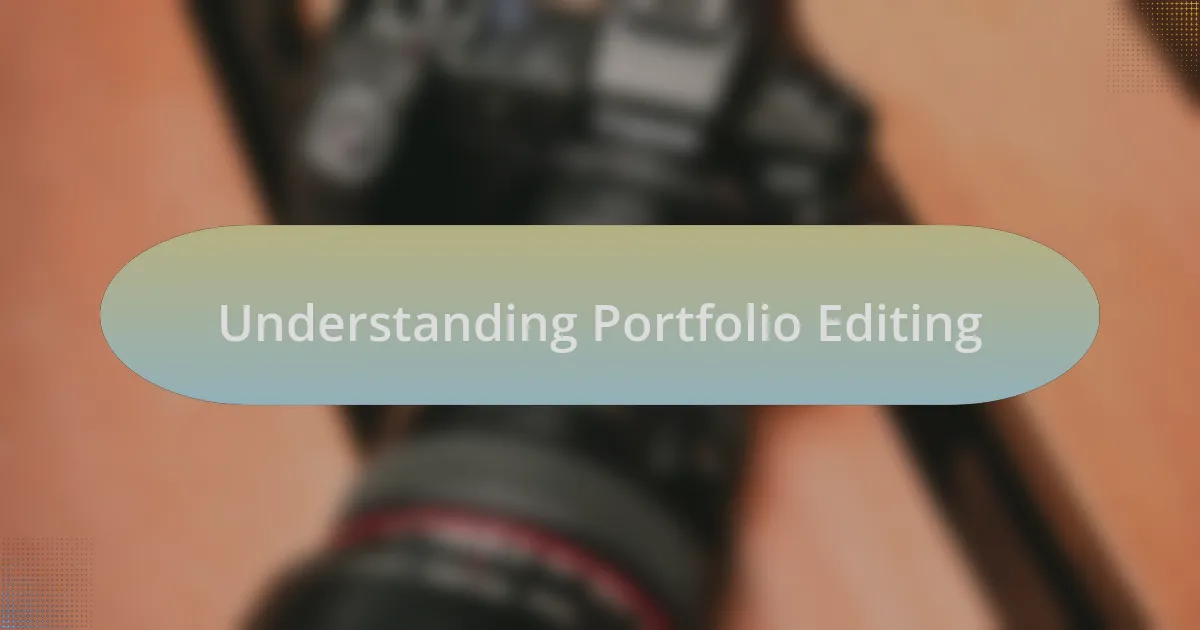
Understanding Portfolio Editing
Portfolio editing is not just about selecting your best photos; it’s a deeply personal process that allows you to showcase your unique vision as a photographer. I remember when I first began editing my portfolio, feeling the weight of each decision. Which images represent me the best? It felt like choosing a favorite child, each one holds its own story.
The emotional aspect of portfolio editing can be overwhelming. There are moments when I questioned whether I was being too critical or overly sentimental about certain images. Have you ever felt torn between the emotional connection to a photo and the need for a cohesive visual narrative? I’ve found that stepping back and viewing my work with fresh eyes often helps in making those tough calls.
In the end, understanding the nuances of your style and the message you wish to convey is essential for effective portfolio editing. I’ve learned to focus not just on individual images, but how they come together to tell a richer story. This approach ultimately transforms the editing process from a chore into a fulfilling exploration of my artistic journey.
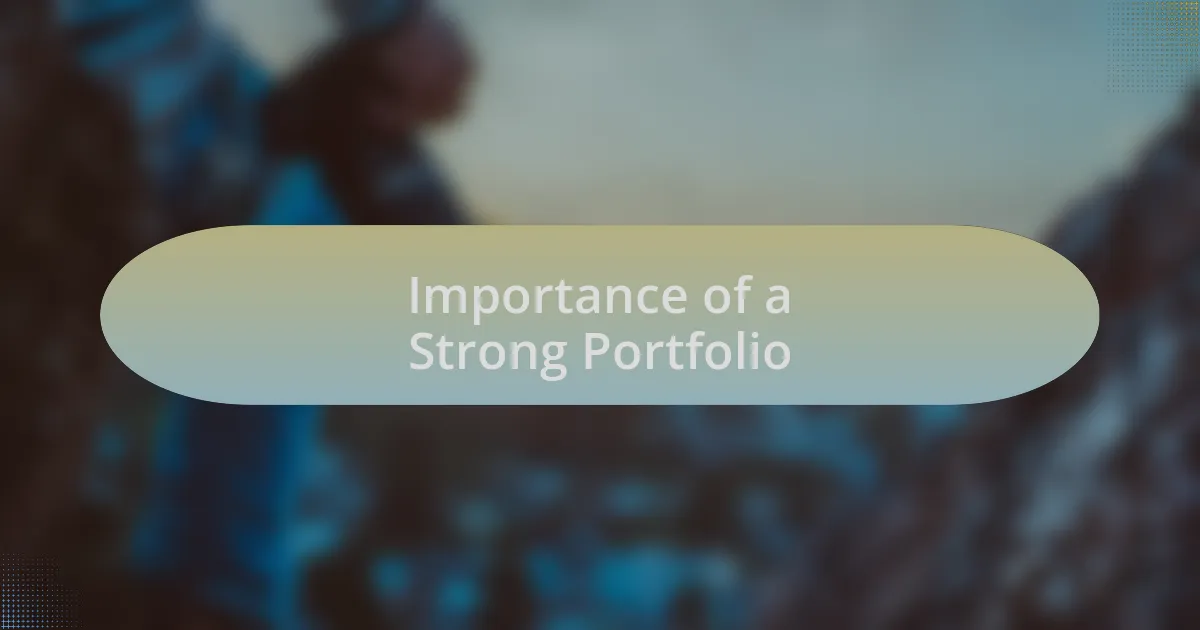
Importance of a Strong Portfolio
Having a strong portfolio is crucial for any photographer looking to leave a lasting impression. I recall presenting my portfolio for the first time and feeling a mix of excitement and anxiety. It’s not just about showcasing pretty pictures; it’s about conveying a story that resonates with viewers. Isn’t it fascinating how a single image can evoke such powerful emotions?
A well-curated portfolio acts as your calling card in the industry. When I started networking, I realized that potential clients and collaborators often made snap judgments based on what they saw in my portfolio. It was a pivotal moment for me—understanding that each piece needed to reflect not only my technical skills but also my personality and artistic voice. Have you considered what your own portfolio says about you?
Moreover, a strong portfolio can set you apart in a competitive field. A few years back, I participated in a local exhibition where I showcased a meticulously edited selection of my work. The feedback was overwhelmingly positive, and it was clear that my efforts to create a cohesive visual narrative made an impression. What do you think helps to create that sense of cohesion in a collection of images? For me, it was about choosing images that not only worked well together but also highlighted my journey as a photographer.
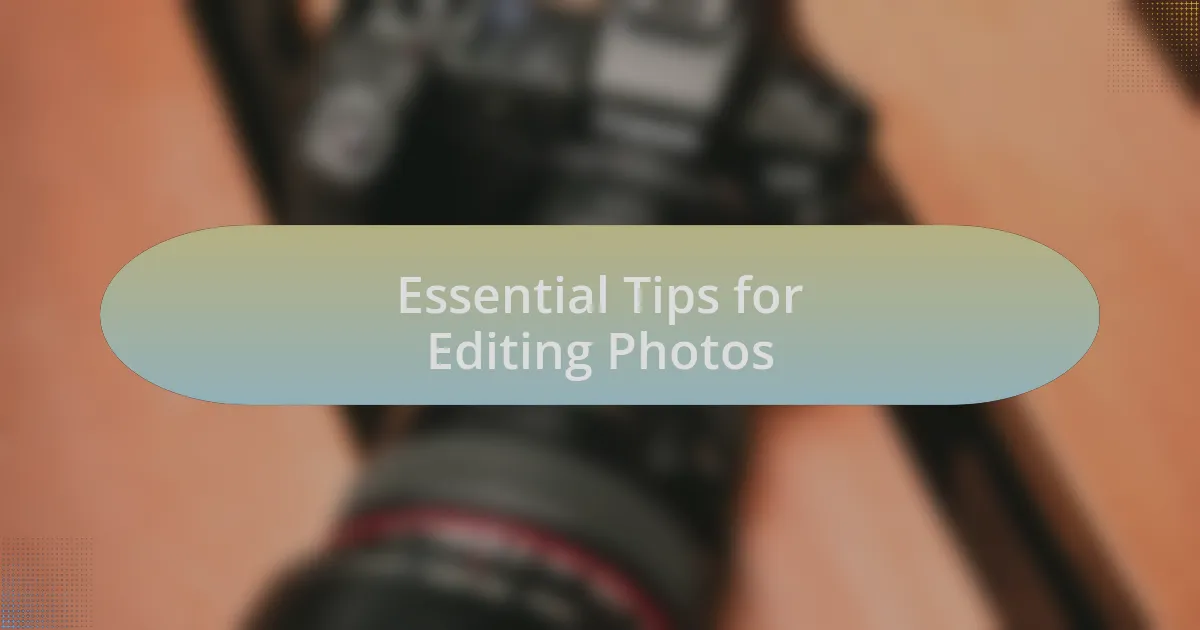
Essential Tips for Editing Photos
Editing photos is an art in itself, and one essential tip I’ve learned is to trust your instincts. When I’m sifting through adjustments, whether it’s color correction or cropping, I often pause to ask myself, “Does this enhance the image or distract from it?” This self-check helps me maintain a clear vision and prevents me from over-editing, which can sometimes dilute the original essence of the photograph.
One technique that has transformed my editing process is utilizing layers effectively. I remember a time when I was baffled by the complexity of layer adjustments. Once I embraced them, however, my workflow became not only efficient but also incredibly freeing. It allowed me to make subtle changes that improved the overall composition while preserving the original character of my work. Have you experimented with layers? If not, I encourage you to dive in—you might be surprised by the flexibility it offers!
Lastly, never underestimate the power of feedback. Early in my career, I often edited in a bubble, thinking my eye was enough. The moment I started sharing my edits with fellow photographers and mentors, I began to see my work more objectively. They offered insights I had never considered, reminding me that collaboration can elevate my edits beyond what I could achieve alone. In your journey, how might sharing your edits sharpen your skills?
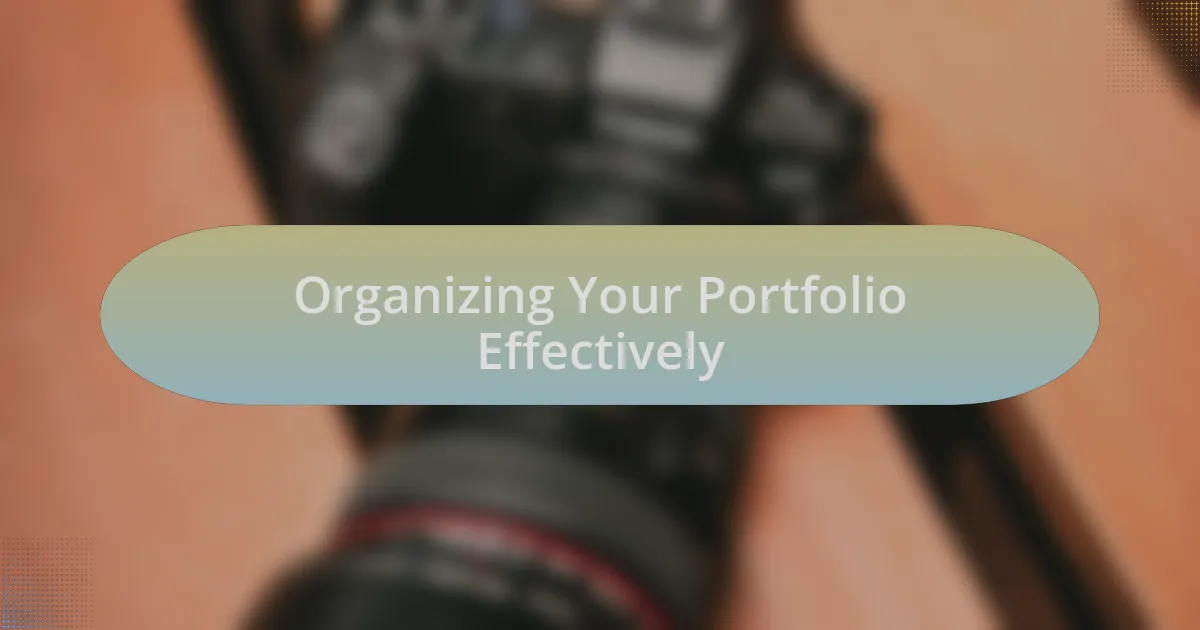
Organizing Your Portfolio Effectively
When it comes to organizing your portfolio, presentation is key. I once spent an entire weekend rearranging my images based on themes and emotions rather than just chronology. This approach transformed how viewers interpreted my work, guiding them through a visual journey that felt intentional and cohesive. Isn’t it amazing how a little thought in arrangement can change the narrative of your photography?
I also believe that quality trumps quantity in portfolio organization. Early on, I was tempted to showcase everything I shot, thinking more was better. However, I soon realized that curating my strongest images not only highlighted my skills but also helped define my style. Have you ever looked back at your earlier work and felt overwhelmed? Simplifying choices can often lead to a more powerful impact.
Additionally, consider the flow of your portfolio as a storytelling tool. In my experience, transitioning between images with a common thread creates a dialogue that keeps viewers engaged. I recall displaying a series of portraits followed by landscapes, only to notice the disconnect that left my audience guessing. By revisiting how I arranged these images, I was able to create a seamless experience that resonated more deeply with anyone who viewed it. How might you approach storytelling in your own portfolio?
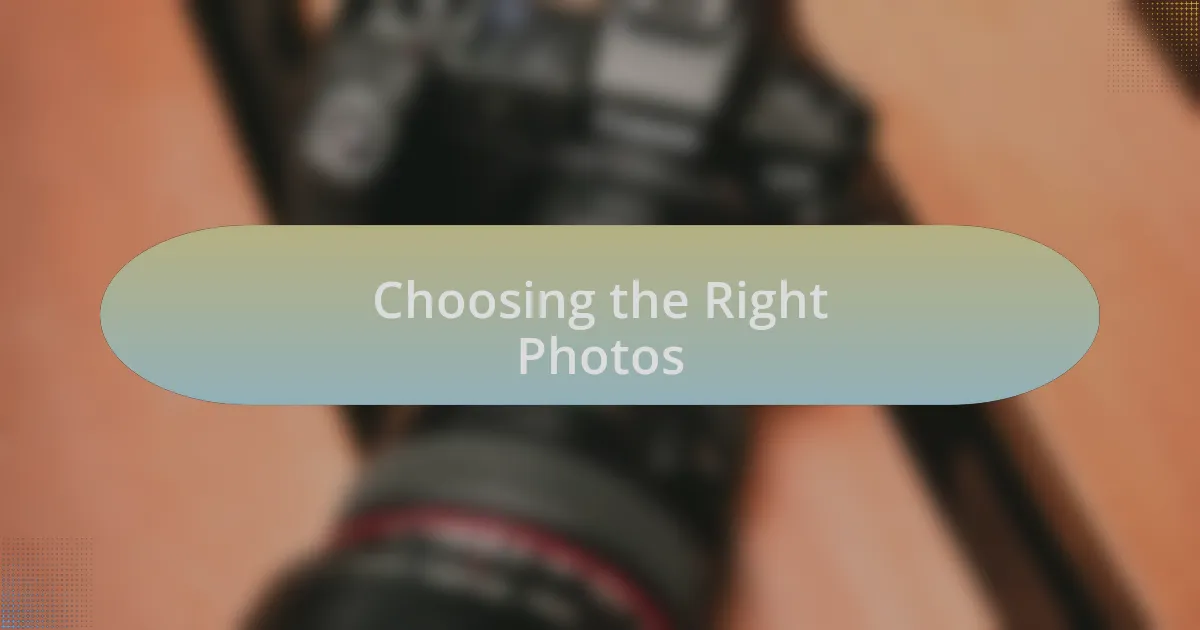
Choosing the Right Photos
Choosing the right photos for your portfolio can be quite the challenge. I remember struggling with this when I was trying to select images for a gallery exhibition. The pressure to impress often clouded my judgment, and I ended up doubting my strongest work. Have you ever felt that way, caught between showcasing your best and fearing it might not be enough?
One strategy that helped me significantly was to seek feedback from trusted fellow photographers. I once shared a batch of my potential portfolio images with a mentor, who meticulously pointed out the strengths and weaknesses of each one. That conversation was eye-opening; it taught me that sometimes, what I loved might not resonate with others. How do you feel about sharing your work with peers? It’s a daunting step, but it can lead to powerful insights and clarity.
Another tip is to remain true to your artistic vision. I vividly recall revisiting a project focused on urban landscapes, which sparked so much passion in me. I realized that including those compelling images in my portfolio not only expressed who I am as a photographer but also attracted the right audience. What reflects your essence? Choosing photos that tell your unique story can truly set you apart from the crowd.
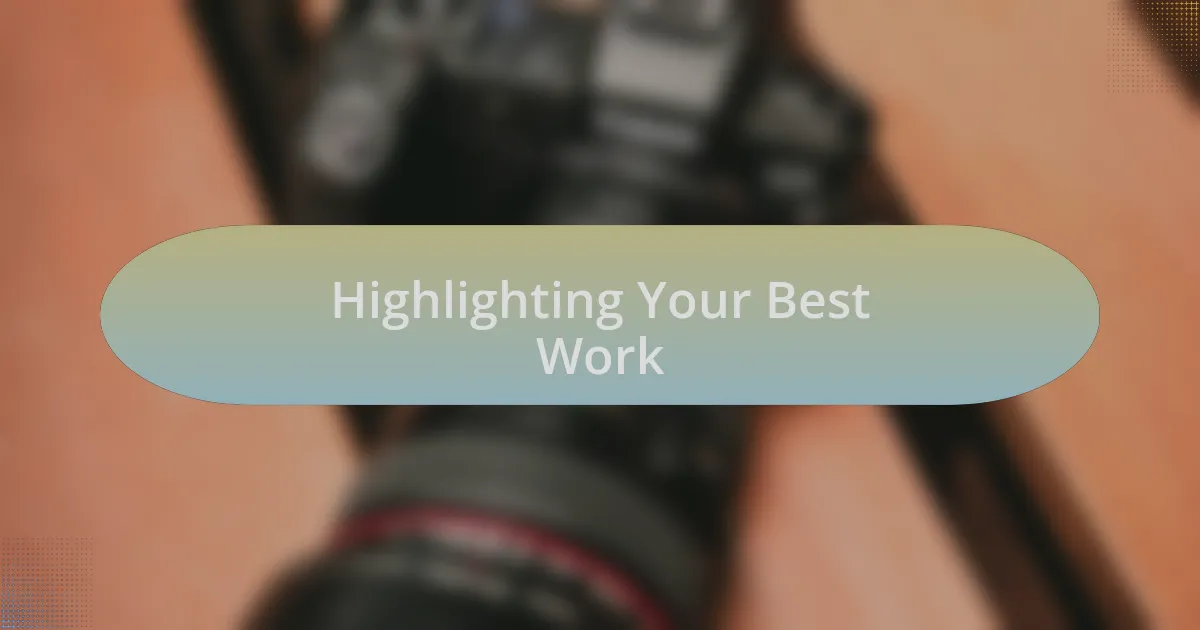
Highlighting Your Best Work
When it comes to highlighting your best work, I’ve found that context can make all the difference. During a recent exhibition, I noticed that certain images captured more attention when accompanied by a brief story behind them. It’s like peeling back the layers of a photograph; sharing what inspired the shot or the challenges I faced added depth and connection. Have you ever thought about how a simple narrative could elevate your images?
Selecting a strong set of images is vital, but I believe that presentation is equally important. I once experimented with different layouts for my online portfolio, and I was amazed at how the sequence of images influenced viewer perception. For example, placing a striking portrait next to a tranquil landscape created a dynamic contrast that engaged visitors. Do you consider how your work flows together? Arranging your best pieces thoughtfully can enhance the overall impact of your portfolio.
One consistent lesson I’ve learned is to trust my instincts when choosing which photographs to showcase. After weeks of deliberation, there was a particular image of a fleeting moment during a street festival that I hesitated to include. However, the raw emotion it captured resonated with my audience more than I anticipated. Have you experienced that moment of doubt only to discover later that it truly showcased your perspective? Embracing the images that stir something within you can resonate deeply with others, making your portfolio not just a collection, but a reflection of your artistic journey.